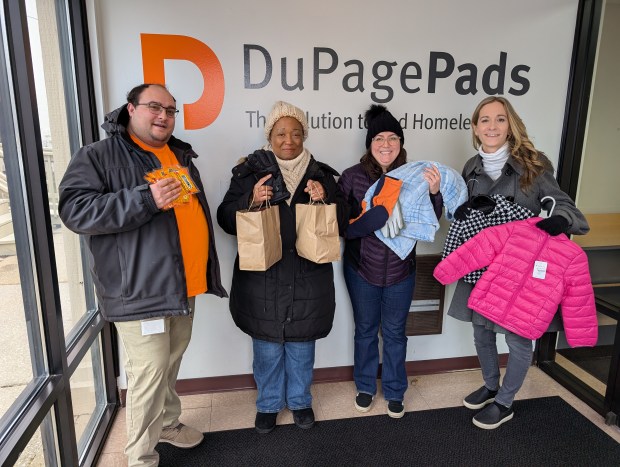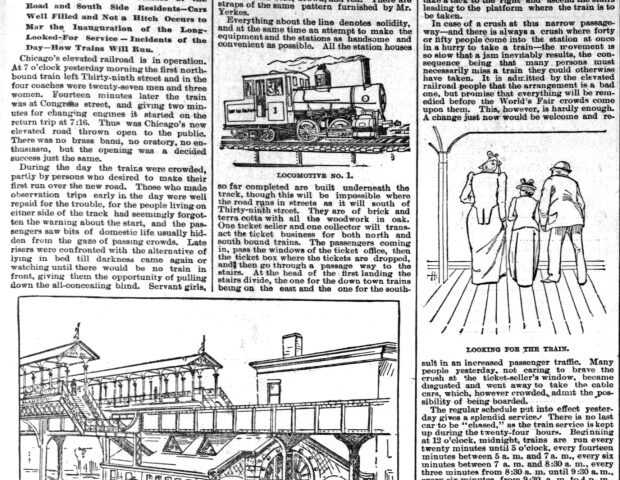After falling on some hard times, David found himself living in his car.
To get by, he’d give plasma for money, the Chicago native said, sharing only his first name for privacy reasons. It helped him buy gas. One night last month, though, it was particularly cold. He had a blanket on with the engine running but it was still freezing, David said.
Needing a place to stay, he tried his chances with DuPagePads. It was a Monday when he approached Wheaton-based nonprofit for help. By Wednesday, he had a roof over his head, he said.
“A blessing,” David said. “A complete blessing.”
This winter, DuPagePads is providing emergency shelter to people across DuPage County in need of lodging through the cold. As of Friday, the emergency program — active since mid-December — had been able to save 124 people who otherwise would have had nowhere else to sleep as frigid temperatures set in, April Redzic, president and CEO of DuPagePads, said.
“I cannot tell you the degree to which we see, every day, people who I don’t think would be OK without … seeking shelter right now,” Redzic said.
Emergency funding
DuPagePads — whose mission is to end homelessness in DuPage County — can supply shelter, food and case management to about 300 people a night through an Interim Housing Center it operates at 1113 Butterfield Frontage Road in Downers Grove.
Heading into this winter, though, need began to creep up.
DuPagePads’ Interim Housing Shelter reached capacity. Then the facility’s waiting list grew to three times its typical length.
Looking for ways to address the uptick, the DuPagePads Board of Directors decided to triple its budget from $50,000 to $150,000 to secure additional beds, Redzic said. Meanwhile, the county caught wind of DuPagePads’ growing waitlist.
In early December, DuPage County Board member Paula Deacon Garcia raised the matter with the board’s Human Services Committee.
Ultimately, to help bolster DuPagePads’ housing capacity, the board allocated $200,000 from the county’s affordable housing fund to the nonprofit. Concurrently, the DuPage Foundation also heeded the call, dedicating $190,000 to the effort.
“The fact is, people who struggle with housing and food insecurity are found in every community in our county,” County Board Chair Deb Conroy said as she presented the funding to DuPagePads in January. “This problem is literally in our back yards.”
The funding has meant everything to David, he said.
“I guess then I’d (otherwise) be in the streets,” he said.
‘Constant fluid movement’
Funding allowed DuPagePads to pay for up to 70 area hotel rooms for emergency shelter, Redzic said. It’s an approach that the nonprofit forged during the COVID-19 pandemic.
Since its inception in 1985, DuPagePads had operated on a model of working with church partner sites across the county to provide emergency shelter on a night by night basis.
That changed during the pandemic, when congregate housing was no longer an option. The agency instead turned to contracting out hotel rooms. In March 2022, it made the shift in model permanent and purchased one of the hotels it had been using, which has since become its Interim Housing Center.
With additional emergency housing through this winter, the goal is to eventually house clients in the Interim Housing Center. The first step, though, is helping stabilize clients in hotel rooms, said Chad Pedigo, DuPagePad’s vice president of development, before they move to the center when space becomes available.
“It’s a constant fluid movement of getting (people) off the streets and being safe first,” Pedigo said. “Then, as we’re working to stabilize them in the introductory period, we’re trying to find a placement (at the center) where they can utilize even more of our services.”
Naperville-based Loaves and Fishes supplies basic provisions “to make sure no one’s going hungry while they’re there,” Pedigo said.
Redzic anticipates the emergency program will run through March, depending on weather and resources. But the goal from the start is “just to get folks out of life-threatening conditions,” she said.
It’s hard to know if the increased need will continue — “I wish I had a crystal ball,” Redzic said — but the escalation didn’t come without warning signs. Homelessness, nationally and locally, has been on the rise since the pandemic.
An uptick in need
In 2023, the United States experienced a 12% increase in homelessness. Last year, it rose even more, going up 18.1%, according to the U.S. Department of Housing and Urban Development.
In DuPage, the number of people experiencing homelessness in the county’s emergency shelter and transitional housing system has also grown, according to Lisa Snipes, continuum planner for DuPage County Continuum of Care. In the reporting period from 2020-21, 760 people experienced homelessness. That increased to 1,101 people from 2021-22, followed by 1,064 people from 2022-23.
The county has seen a jump in family and youth homelessness in particular, Snipes said.
Nationally, the uptick has been driven by soaring rents, the end of pandemic assistance and the surge of migrants in several parts of the country.
Locally, Snipes pointed to much of the same, though she said new arrivals tended to pass through DuPage rather than staying, as opposed to Chicago, which bore the brunt of the influx.
Underscoring affordability in DuPage especially, the “need and availability of affordable housing stock continues to be a high priority for us,” she said.
To afford a two-bedroom apartment at fair market rent in the Chicago-Joliet-Naperville metropolitan area, which includes DuPage County, a person would need to earn an hourly wage of $32.96, or about $68,560 a year, according to a June 2024 report from Housing Action Illinois and the National Low Income Housing Coalition. At minimum wage, a person would need to work nearly two-and-a-half full-time jobs.
In a December 2023 report from the Illinois Housing Development Authority ranking some 1,300 local governments across the state relative to their affordable housing share, 16 places in DuPage were among the top 100 least affordable communities. Of those, five had an affordable housing stock that accounted for less than 10% of their total year-round real estate. Naperville’s affordable housing share just narrowly surpassed the cutoff, totaling 10.3%, the report found.
Thinking long-term
Affordability constraints make it difficult to find permanent housing for sheltered clients, Snipes said.
“So you enter into a shelter and then you’re working with a case manager on a housing plan,” she said. “And a housing plan is to get you out as soon as possible into your next unit. We are finding that that next unit is unaffordable for many, if not all, of our sheltered clients.”
That means people experience homelessness longer. The median number of days individuals spent in emergency shelters and safe havens in DuPage was 143 in 2023, according to the most recently reported data from the DuPage County Continuum of Care’s Community Performance Dashboard.
In 2020, the median number of days was 36, dashboard data shows. That jumped to 122 in 2021 and has continued to climb since. Meanwhile, the county reported a 49% success rate of placing clients into permanent housing in 2023, which is 18% higher than the county’s rate in 2019.
Snipes attributed that increase to the county’s emergency shelter system moving away from that congregate model DuPagePads had relied on for decades.
“Now that we have a non-congregate shelter, everything is in one place,” she said. “We have the opportunity to work with them … through some of their housing concerns and challenges.”
Still, the improvement has not been fast enough to keep the time people experience homelessness from rising, Snipes said.
Though recognizing the county’s housing challenges, Snipes said they also “give us opportunities to work harder with our lawmakers and our legislators so that we can provide awareness of the need.”
She pointed to an Ad-Hoc Housing Solutions Committee the county formed in 2023 to address issues of affordable housing.
As she looks ahead, Redzic said, “We’re watching what’s happening in the affordable housing arena very closely to see what folks are doing there, knowing how markedly it impacts the people we are serving.
“We all want everyone to survive,” she said. “And so we’re going to continue planning around what we can to make that happen. My hope comes from the folks we work with in the community, who have been incredible. … The people of DuPage County have over and over inspired me with how generous they are. I’ve never seen anything like it.”
The Associated Press contributed.




